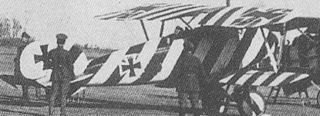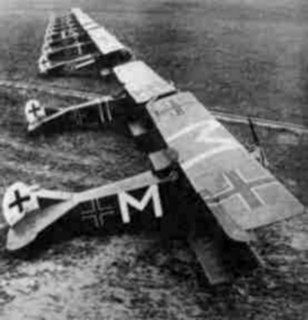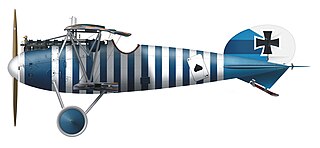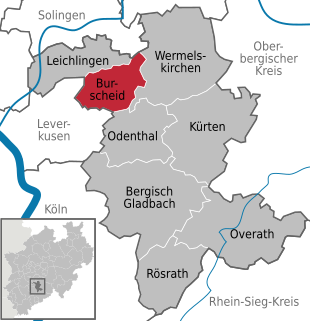Royal Prussian Jagdstaffel 37, commonly abbreviated to Jasta 37, was a "hunting group" of the Luftstreitkräfte, the air arm of the Imperial German Army during World War I. The unit would score over 70 aerial victories during the war, including 13 observation balloons downed. The squadron's victories came at the expense of seven killed in action, two killed in flying accidents, three wounded in action, and three taken prisoner of war.

Royal Prussian Jagdstaffel 39, commonly abbreviated to Jasta 39, was a "hunting group" of the Luftstreitkräfte, the air arm of the Imperial German Army during World War I. The unit would score 68 aerial victories during the war, including 14 observation balloons downed. The squadron's victories came at the expense of seven pilots killed in action, one killed in a flying accident, five wounded in action, and one taken prisoner of war.
Royal Saxon Jagdstaffel 40, commonly abbreviated to Jasta 40, was a "hunting group" of the Luftstreitkräfte, the air arm of the Imperial German Army during World War I. The unit would score over 54 aerial victories during the war, including three observation balloons downed. The squadron's victories came at the expense of five killed in action, one killed in a flying accident, and six wounded in action.
Royal Prussian Jagdstaffel 41, commonly abbreviated to Jasta 41, was a "hunting group" of the Luftstreitkräfte, the air arm of the Imperial German Army during World War I. The unit would score 73 aerial victories during the war, including ten observation balloons downed. The squadron's victories came at the expense of ten killed in action, two killed in flying accidents, three wounded in action, and one taken prisoner of war.
Royal Prussian Jagdstaffel 42, commonly abbreviated to Jasta 42, was a "hunting group" of the Luftstreitkräfte, the air arm of the Imperial German Army during World War I. The unit would score over 30 aerial victories during the war. The squadron's victories came at the expense of four killed in action, one wounded in action, and one taken prisoner of war.
Royal Prussian Jagdstaffel 43, commonly abbreviated to Jasta 43, was a "hunting group" of the Luftstreitkräfte, the air arm of the Imperial German Army during World War I. The unit would score over 35 aerial victories during the war, including two observation balloons downed. The squadron's victories came at the expense of six killed in action, five wounded in action, two injured in accidents, and one taken prisoner of war.
Royal Prussian Jagdstaffel 45, commonly abbreviated to Jasta 45, was a "hunting group" of the Luftstreitkräfte, the air arm of the Imperial German Army during World War I. The squadron would score over 113 aerial victories during the war, including 28 observation balloons downed. The unit's victories came at the expense of four pilots killed in action, two injured in flying accidents, and five wounded in action.
Royal Württemberg Jagdstaffel 47, commonly abbreviated to Jasta 47 or Jasta 47W, was a "hunting group" of the Luftstreitkräfte, the air arm of the Imperial German Army during World War I. Incomplete records credit the squadron with 14 aerial victories during the war. The unit's known casualties include three killed in action, one injured in a flying accident, three wounded in action, and one taken prisoner of war.
Royal Prussian Jagdstaffel 48, commonly abbreviated to Jasta 48, was a "hunting group" of the Luftstreitkräfte, the air arm of the Imperial German Army during World War I. The squadron would score six aerial victories by the end of August 1918; records past that date are missing. The unit's victories came at the expense of five pilots killed in action, two killed in flying accidents, one wounded in action, and one taken prisoner of war.
Royal Prussian Jagdstaffel 49, commonly abbreviated to Jasta 49, was a "hunting group" of the Luftstreitkräfte, the air arm of the Imperial German Army during World War I. The squadron would score 28 aerial victories during the war, including at least one observation balloon. The unit's victories came at the expense of one pilot killed in action and three wounded in action.

Royal Prussian Jagdstaffel 50, commonly abbreviated to Jasta 50, was a "hunting group" of the Luftstreitkräfte, the air arm of the Imperial German Army during World War I. The squadron would score over 45 aerial victories during the war, including 14 observation balloons downed. The unit's victories came at the expense of five killed in action, one wounded in action, and three taken prisoner of war. The squadron was disbanded on 17 January 1919.
Royal Prussian Jagdstaffel 52, commonly abbreviated to Jasta 52, was a "hunting group" of the Luftstreitkräfte, the air arm of the Imperial German Army during World War I. The squadron would score over 42 aerial victories during the war. The unit's victories came at the expense of eight killed in action, one injured in a flying accident, one wounded in action, and one taken prisoner of war.
Royal Prussian Jagdstaffel 53, commonly abbreviated to Jasta 53, was a "hunting group" of the Luftstreitkräfte, the air arm of the Imperial German Army during World War I. The squadron would score over 20 aerial victories during the war. The unit's victories came at the expense of one pilot killed in a flying accident, another injured in an accident, one wounded in action, and four taken prisoner of war.
Royal Prussian Jagdstaffel 68, commonly abbreviated to Jasta 68, was a "hunting group" of the Luftstreitkräfte, the air arm of the Imperial German Army during World War I. The squadron would score over 40 aerial victories during the war, including ten observation balloons downed. The unit's victories came at the expense of nine killed in action, and two wounded in action.
Royal Prussian Jagdstaffel 69, commonly abbreviated to Jasta 69, was a "hunting group" of the Luftstreitkräfte, the air arm of the Imperial German Army during World War I. The squadron would score 15 aerial victories during the war, including two observation balloons downed. The unit's victories came at the expense of one pilot killed in action, three killed in flying accidents, one wounded in action, and three taken prisoner of war.
Royal Prussian Jagdstaffel 71, commonly abbreviated to Jasta 71, was a "hunting group" of the Luftstreitkräfte, the air arm of the Imperial German Army during World War I. The squadron would score eight aerial victories during the war, including three observation balloons downed. The unit's victories came at the expense of four killed in action and one wounded in action.

Royal Saxon Jagdstaffel 72, commonly abbreviated to Jasta 72, was a "hunting group" of the Luftstreitkräfte, the air arm of the Imperial German Army during World War I. The squadron would score over 58 aerial victories during the war, including three observation balloons downed. The unit's victories came at the expense of two killed in action, one wounded in action, and one taken prisoner of war.
Royal Bavarian Jagdstaffel 76, commonly abbreviated to Jasta 76, was a "hunting group" of the Luftstreitkräfte, the air arm of the Imperial German Army during World War I. The squadron would score over 20 aerial victories during the war. The unit's victories came at the expense of six killed in action, four wounded in action, and three taken prisoner of war.
Royal Bavarian Jagdstaffel 77, commonly abbreviated to Jasta 77, was a "hunting group" of the Luftstreitkräfte, the air arm of the Imperial German Army during World War I. The squadron would score over 28 aerial victories during the war, including three observation balloons downed. The unit's victories came at the expense of four killed in action, one killed in a flying accident, one wounded in action, three injured in aviation accidents, and one taken prisoner of war.

Royal Bavarian Jagdstaffel 79, commonly abbreviated to Jasta 79, was a "hunting group" of the Luftstreitkräfte, the air arm of the Imperial German Army during World War I. The squadron would score over 28 aerial victories during the war, including three observation balloons downed. The unit's victories came at the expense of four killed in action, three killed in flying accidents, 13 wounded in action, two injured in aviation accidents, and three taken prisoner of war.










